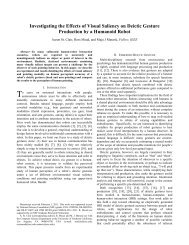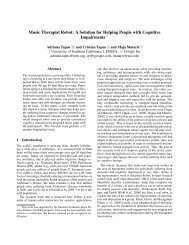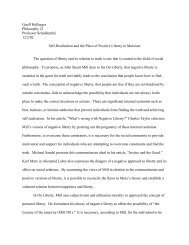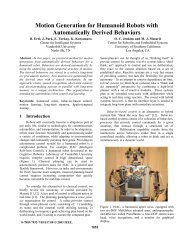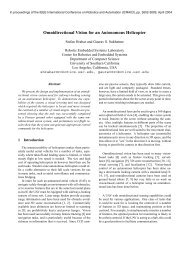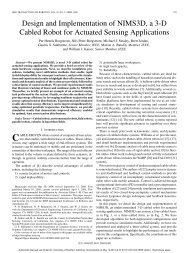Fasola & Matarić. A SAR <strong>Exercise</strong> <strong>Coach</strong> <strong>for</strong> <strong>the</strong> <strong>Elderly</strong>Fur<strong>the</strong>rmore, it is important that <strong>the</strong> tasks not only be healthcare-driven, but that <strong>the</strong>yalso be successful in achieving <strong>the</strong> desired <strong>the</strong>rapeutic behavior; in <strong>the</strong> case of our SARexercise coach, this means <strong>the</strong> interaction must elicit consistent physical exercise among<strong>the</strong> users (measurable through objective quantitative metrics), a result that was achievedin our user study with older adults as detailed in Section 5.3.1.2 Discussion of Design PrinciplesOur five SAR design principles were developed in an attempt to capture and address <strong>the</strong>key components necessary <strong>for</strong> successful SAR-based <strong>the</strong>rapy. Each of <strong>the</strong> designprinciples was developed based on findings from research in psychology, specifically in<strong>the</strong> areas of intrinsic motivation and trust, and from research in HCI and HRI, specificallyregarding <strong>the</strong> effects of relational agent behaviors on user engagement. Although someprevious work has addressed <strong>the</strong> design of social agents <strong>for</strong> obtaining long-termengagement and trust, most has focused on agent guidance in task scenarios in which <strong>the</strong>agent does not monitor or instruct <strong>the</strong> activity itself (e.g., Bickmore & Picard, 2005; Kidd& Breazeal, 2008).We have presented a set of five clear and general SAR design principles that can beapplied to a variety of different SAR-based <strong>the</strong>rapeutic domains, including those wherein<strong>the</strong> SAR agent provides real-time instruction, activity monitoring, active guidance andfeedback, task participation, and continuity behaviors spanning multiple sessions ofinteraction. In <strong>the</strong> following sections we provide examples of how to incorporate <strong>the</strong>sedesign principles into practice with a SAR agent, as we elaborate on <strong>the</strong> implementationdetails of our SAR exercise system developed to engage older adults in physical exercise.In Sections 4 and 5 we discuss a user study conducted with older adults to evaluateour SAR approach, design, and algorithms in motivating task engagement andper<strong>for</strong>mance. It is important to note, however, that <strong>the</strong> focus of <strong>the</strong> study was not onvalidating each of <strong>the</strong> five design principles independently. Prior work by our group ando<strong>the</strong>rs has already demonstrated <strong>the</strong> positive effect of many aspects of <strong>the</strong> above designprinciples individually. For example, previous studies conducted by our lab have shown<strong>the</strong> positive influence on intrinsic motivation and user engagement of online taskmodification to achieve optimal challenge (Fasola & Matarić, 2010a), praise andrelational discourse, adjustable user autonomy, and fluidity of interaction (Fasola &Matarić, 2012). Instead, <strong>the</strong> focus of <strong>the</strong> conducted user study was on <strong>the</strong> evaluation ofour SAR exercise system and design principles as a whole, in addition to investigating<strong>the</strong> role of physical embodiment and its effect on user intrinsic motivation and userattitudes towards <strong>the</strong> system.3.2 Interaction ScenarioOur robot exercise system consists of a socially assistive robot whose purpose is tomonitor, instruct, evaluate, and encourage users to per<strong>for</strong>m simple physical exercise.During <strong>the</strong> exercise sessions, <strong>the</strong> robot asks <strong>the</strong> user to per<strong>for</strong>m seated arm gestureexercises. This type of seated exercise, called “chair exercise” or “chair aerobics,” iscommonly practiced in senior living facilities. Chair exercises are highly regarded <strong>for</strong><strong>the</strong>ir accessibility to those with low mobility, <strong>for</strong> <strong>the</strong>ir safety, and <strong>for</strong> <strong>the</strong>ir healthbenefits, such as improved flexibility, muscle strength, ability to per<strong>for</strong>m everyday tasks,and even memory recall (Baum et al., 2003; Dawe & Moore-Orr, 1995; McMurdo &Rennie, 1993; Thomas & Hageman, 2003).8
Fasola & Matarić. A SAR <strong>Exercise</strong> <strong>Coach</strong> <strong>for</strong> <strong>the</strong> <strong>Elderly</strong>Figure 1. The setup <strong>for</strong> <strong>the</strong> one-on-one interaction between user and robot coach.The one-on-one interaction scenario consists of <strong>the</strong> user sitting in a chair facing <strong>the</strong>robot. In this system, predating <strong>the</strong> availability of <strong>the</strong> Microsoft Kinect, <strong>the</strong> range of <strong>the</strong>robot’s arm motion in <strong>the</strong> exercises is planar and restricted to <strong>the</strong> sides of <strong>the</strong> body inorder to maximize <strong>the</strong> accuracy of <strong>the</strong> robot’s real-time visual detection of <strong>the</strong> user’sarms. A black curtain is used as a backdrop, also to facilitate <strong>the</strong> robot’s visual perceptionof <strong>the</strong> user’s arm movements. An example of <strong>the</strong> exercise setup and human-robotinteraction is shown in Figure 1.The system allows <strong>the</strong> user to communicate with <strong>the</strong> robot through <strong>the</strong> popularNintendo Wiimote wireless Bluetooth button control interface. There are two buttonsavailable <strong>for</strong> <strong>the</strong> user to respond to prompts from <strong>the</strong> robot, labeled “Yes” and “No,” andone button <strong>for</strong> <strong>the</strong> user to request a rest break at any time during <strong>the</strong> interaction. TheWiimote is not used <strong>for</strong> motion sensing of any kind; its role is solely <strong>for</strong> communicationwith <strong>the</strong> robot through button presses. It is also important to note that <strong>the</strong> robot conducts<strong>the</strong> exercise sessions, evaluates user per<strong>for</strong>mance, and gives <strong>the</strong> user real-time feedbackall completely autonomously, without human operator intervention at any time during <strong>the</strong>exercise sessions.3.3 <strong>Exercise</strong> GamesFour exercise games are available in our system: <strong>the</strong> Workout game, <strong>the</strong> Sequence game,<strong>the</strong> Imitation game, and <strong>the</strong> Memory game. Each game presents a different level ofchallenge and necessary skill set, in accordance with our system methodology of varyinggame types <strong>for</strong> increased user enjoyment and to promote intrinsic motivation in <strong>the</strong><strong>the</strong>rapeutic interaction. Following is a brief description of each game.3.3.1 Workout GameIn <strong>the</strong> Workout game, <strong>the</strong> robot fills <strong>the</strong> role of a traditional exercise instructor bydemonstrating <strong>the</strong> arm exercises with its own arms and asking <strong>the</strong> user to imitate. Therobot shows only one exercise gesture at a time (involving one or both arms). Uponsuccessful completion by <strong>the</strong> user, <strong>the</strong> robot generates a different gesture and <strong>the</strong> processrepeats. The robot gives <strong>the</strong> user feedback in real time, providing corrections whenappropriate (e.g., “Raise your left arm and lower your right arm” or “Bend your left<strong>for</strong>earm inward a little”), and praise in response to each successful imitation (e.g., “Great9



